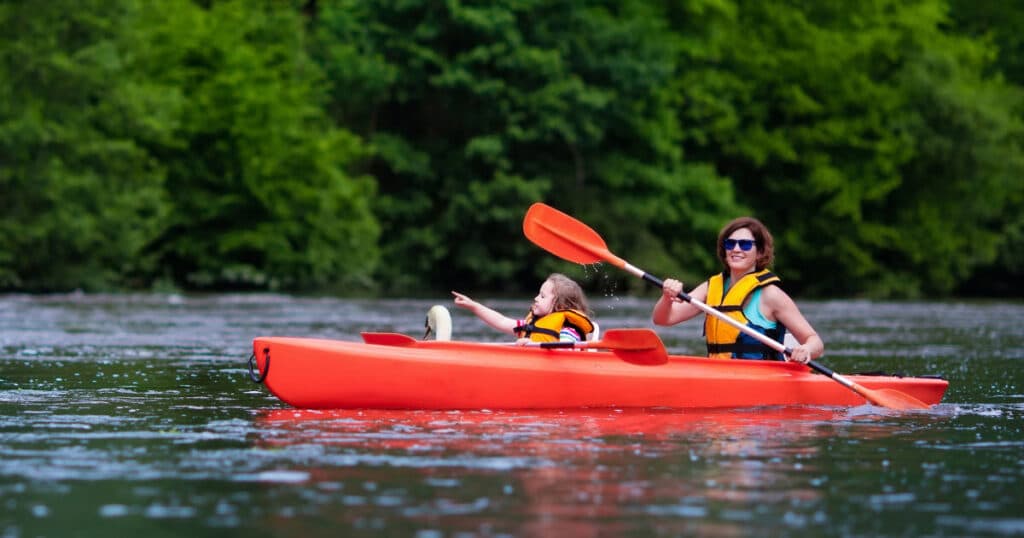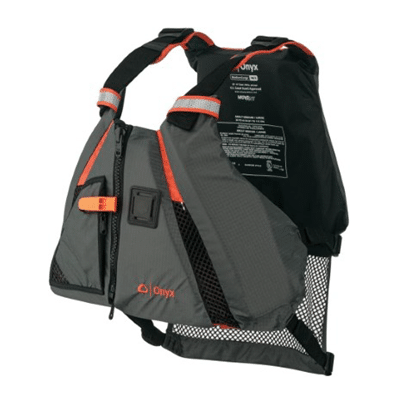If you’re a parent and enjoy the outdoors, you are probably eager to share the experience with your children. But remember, safety first! Maybe you want to bring them along on a kayaking adventure. But how can you do this safely? Keep reading to find out about using a tandem kayak with a child seat.
A tandem kayak with a child seat is the way to go. You can introduce your children to paddling skills. It also gives you, the parent, a sense of control and security.
| PeacefulPaddle.com is reader supported. If you make a purchase after clicking a link, I may earn a commission at no additional cost to you. |
What is a Tandem Kayak?
A tandem kayak is a kayak that lets two people paddle at the same time. You’ll sometimes hear people call it a “double kayak.”
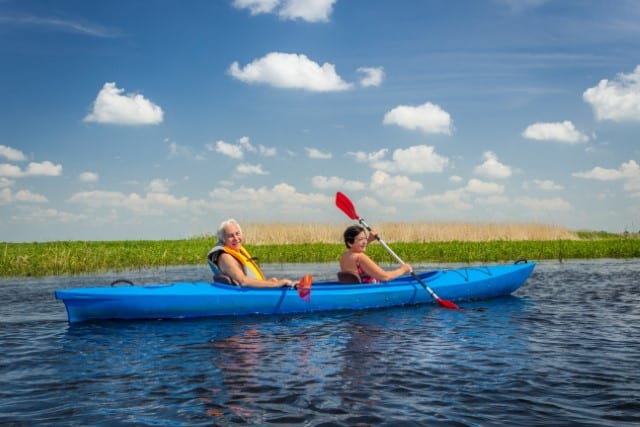
As they’ve got to fit two people, tandem kayaks are roomier. Specifically, they are wider and longer. The fact they’re wider than single kayaks means that they tend to be more stable.
Tandem Kayaks Are Popular With Families
A tandem kayak is perfect if you want to introduce your child to kayaking. With this kind of kayak, you and your kid can paddle together in the same boat!
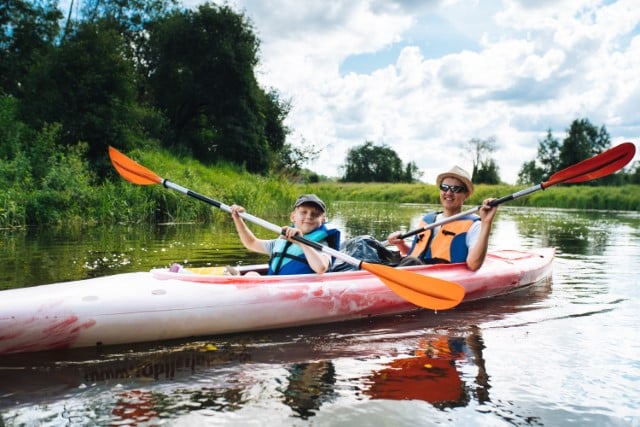
It can be challenging and even dangerous to try to teach your child how to kayak when they’re separate from you in their own watercraft. In a tandem kayak, you can fully supervise your child and make sure things don’t go awry.
Child Seat for Your Tandem Kayak
It’s best to buy a tandem kayak with a child seat already built-in. If your tandem kayak doesn’t already have a child seat, you should add one. For example, you can find a drop-in child seat.
Many child seats are made to have a universal fit. In other words, there’s a good chance they’ll fit no matter the size of your kayak.
Look for a kayak child seat that has the right features, such as a fully adjustable seat back and skid-resistant bottom. There are several child seats that don’t need to be fastened or clipped.
Make sure you read the instructions that come with your seat. Each one has its own specifications, and you have to use it the right way for your child to be safe.
I’ve never used it, but the Harmony Gear kid’s child seat on Amazon seems like a well-reviewed drop-in kayaking seat for kids.
How to Stay Safe in Your Tandem Kayak
Now you know what a tandem kayak is and how you can pilot it together with your child. Let’s talk about our safety tips for using a tandem kayak with a child seat.

You Should Be An Experienced Kayaker
Never bring a child kayaking until you’re already skilled in the sport.
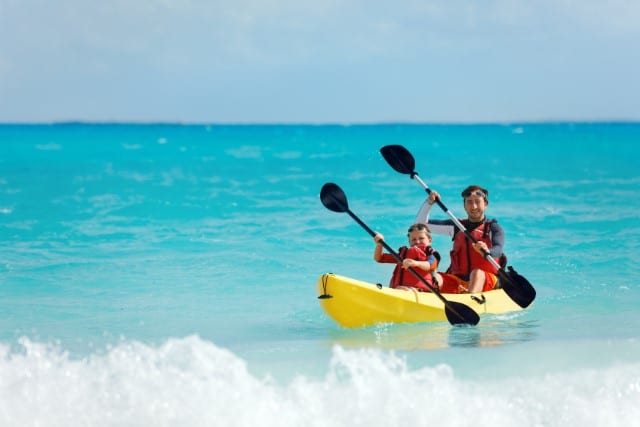
If you haven’t gone kayaking in a while, go kayaking with another adult before you try taking the family.
Wear PFDs (Personal Floatation Devices)
Remember, personal flotation devices are essential (pro tip: get kids used to PFDs before the trip – sometimes children do not enjoy wearing them).
The PFDs you get for yourself and your kids must be properly fitted. An improperly fitted PFD won’t make you safer. In fact, it may cause an additional hazard in some cases.
PFD sizing has categories for infants, children, and youth. In this system, eight to 30 pounds is the infant category, 30 to 50 pounds is the children category, and 50-90 pounds is the youth category.
Have the Right Paddles
You need appropriately sized paddles for both people in your tandem kayak. Ask an expert when choosing the right paddle size for your child.

A good paddle size for many kids is approximately 200 centimeters long. The shaft should be narrow.
Depending on your child’s current age, they may need new, larger paddles later on.
Wear Appropriate Clothing
It’s important to wear the right clothes for kayaking. Examples include warm outerwear, rain gear, wide-brimmed hats, and waterproof footwear.
Of course, the right clothing will partly depend on the day’s weather. You’ll also want items on hand in case the conditions change.
Remember to check the weather report and boating conditions before heading out on the weather.
When it comes to dressing for kayaking, one helpful tip is to keep things waterproof and comfortable.
Popular materials for kayaking garments include breathable polyester weaves, merino wool, and water-resistant shell.
Stay away from cotton. You and the kids are bound to get splashed, and cotton is famous (or infamous) for staying wet and soggy.
Sun Protection
Sunburn is painful and can be dangerous for kids.
You can find clothing that has sun protection built in. You and your child should also wear sunscreen with a high SPF.
Check Your Gear for Wear and Tear
This should be among your priorities when it comes to kayaking activities. Check for wear and tear.
Make sure you have everything before you head out. Check to see if your equipment works for you before letting your children use it.
Keep a First Aid Kit and Kayak Repair Kit on Hand
Keep a first aid kit and a kayak repair kit on hand at all times when out on the water.

There are several kayaking first aid kits available on the market. You can choose one of them or put together a kit on your own.
I like this waterproof first aid kit on Amazon – it’s got pretty much everything you need and will keep things nice and dry.
Bring Drinking Water and Food
Have some bottled water and snacks in your kayak.
Choose Appropriate Water and Weather Conditions
Choose tranquil waters for your kayaking trip with the kids. There should be very little current.
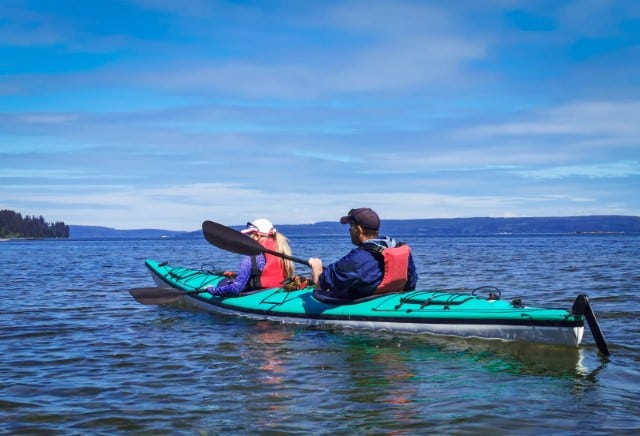
Do you have any small lakes with little boat traffic in your area? Maybe one of those would be a good choice.
Remember to check ahead for weather forecasts. Remember that they can change, and check them a few times before you head out on the water.
There are certain kinds of weather you should avoid when kayaking.
If there’s any chance of these conditions in the forecast, it’s not the right day for a water adventure. These include conditions like high winds, fogs, lightning, and storms.
Know Your Location
As the parent, it is imperative that you know the location where you plan to take your children kayaking. This includes knowing the terrain beforehand so you can navigate it with confidence.
Are you kayaking somewhere new? Ask locals and do research to find information on the specific conditions you’ll find. Being prepared is the key.
Give Your Child Lessons First
This includes not just kayaking lessons, but swimming lessons too.
Even if you believe your kids already have decent swimming skills, bring them to some swimming lessons. Ask the instructor to evaluate their skills and whether it would be safe to bring them kayaking.
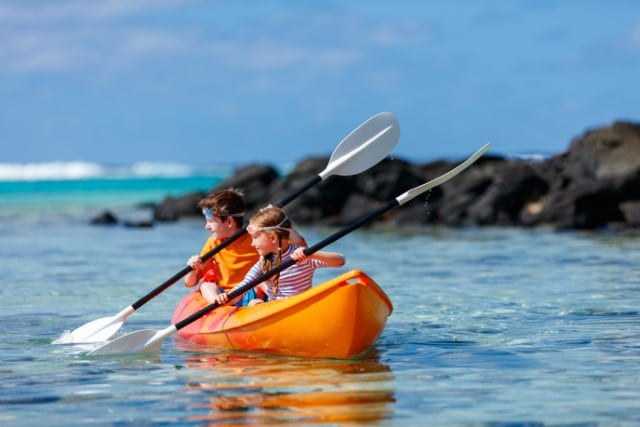
Assign little tasks for them on the trip to empower them as well and make them feel they are contributing to the trip. Teach your child how to enter and exit the kayak safely. Hold their hands if you have to.
Ensure your child is familiar with your kayak and is skilled at paddling. Be patient and spend plenty of time teaching your child how to paddle.
One way to do that is by showing them videos and practicing paddling with them before going on the trip. While planning the trip, it is important to get your kids excited for the adventure.
Paddling a Tandem Kayak
You should realize that tandem paddling is quite different from regular kayak paddling. One of the trickiest aspects is how you have to paddle at the same rate and with the same rhythm.
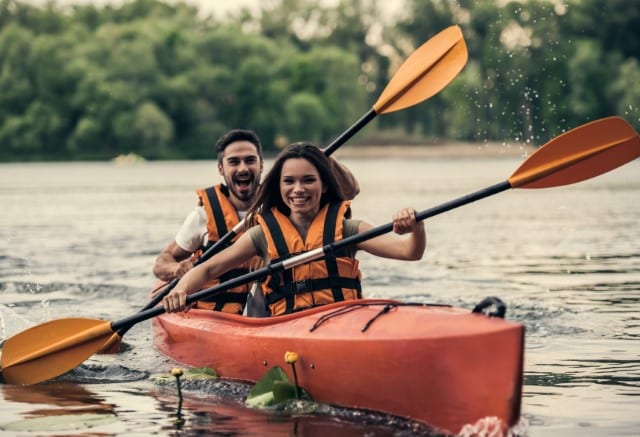
If you’re not in synch, your kayak will have trouble moving smoothly through the water.
One of the first questions parents have is where they should sit in the kayak, and where their child should sit.
The answer is simple: you should sit in the back of the kayak. That is because you’re stronger.
Your child, on the other hand, should sit at the front. They are the person who will determine the pace. But you’re the one providing the power from this rear position.
Of course, your child’s age and size will play a big part here. If your child is very young, you might decide to do all the paddling yourself.
Practice Together
You and your child will have to be patient as you practice paddling together.

Remember to practice all the usual safety precautions for kayaking with your child, even when you’re just practicing. Make sure you both have your life jackets (PFDs) on at all times when you’re on the water.
Try to figure out a way of practicing the paddle movements without actually being out on the water. Teach your child the movements and talk them through them in advance.
You could watch some kayaking for beginners videos with your kids, too. Look for videos geared to kids, so they’ll be engaging and keep your child’s interest.
Final Words on Using a Tandem Kayak with a Child Seat
So, now you know about tandem kayaks with child seats! Not all tandem kayaks come with built-in child seats.
If you already have a tandem kayak and it doesn’t have a child seat, buy a drop-in kayak child seat. Make sure to read the instructions that come with the seat, to use it safely and correctly.
The child seat must be an appropriate size for your child. As your child grows over the years, you’ll have to replace the seat.

